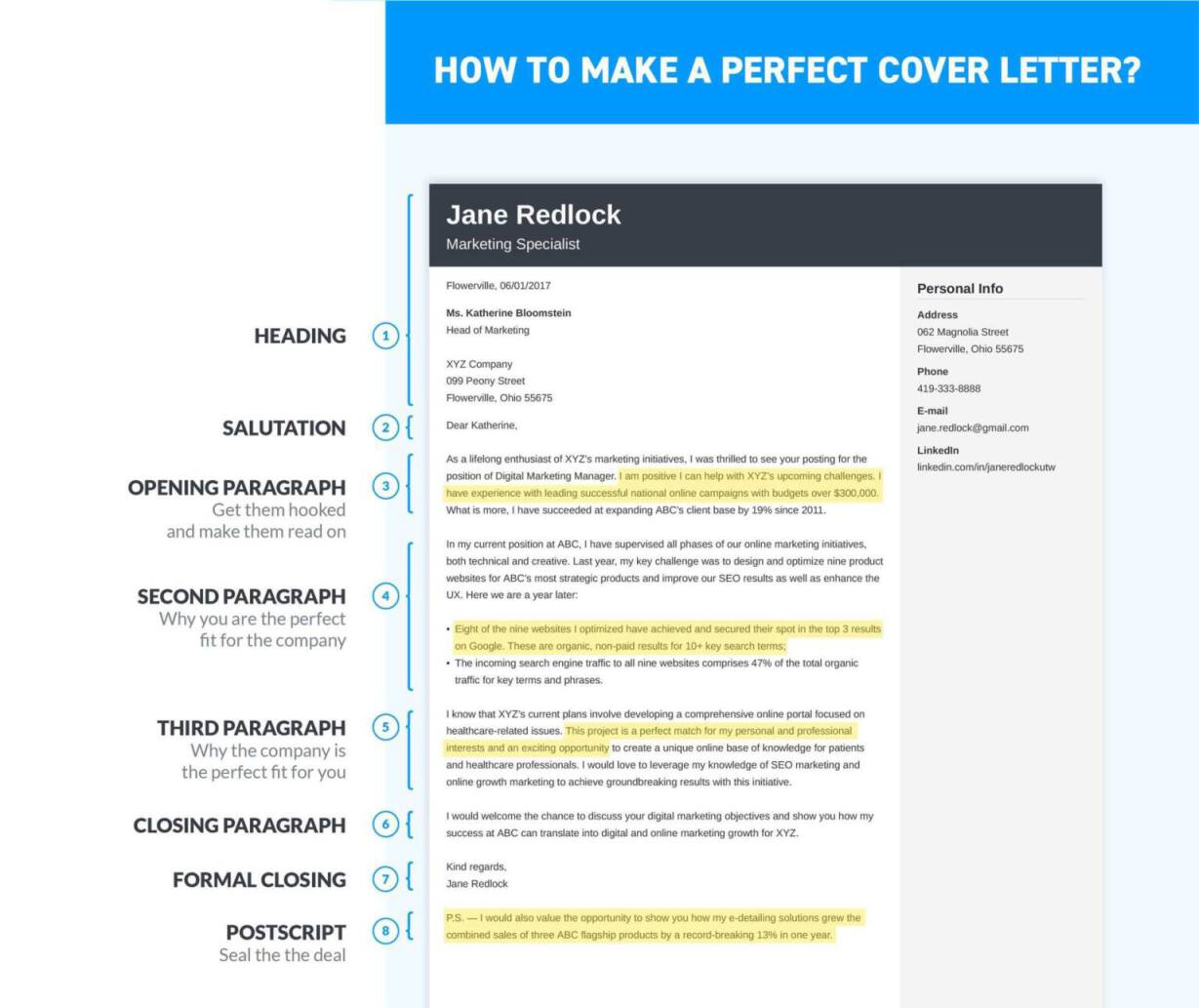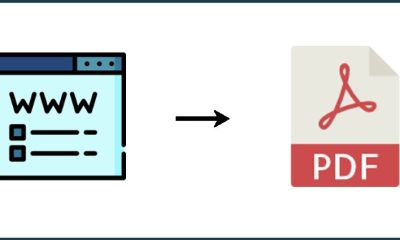Career Tips
How To Write A Cover Letter For Any Job In 2024

A cover letter is an opportunity to highlight your personality and expertise. More than that, it can demonstrate why you are the best applicant for the position. Knowing how to create a cover letter can have a huge impact on your career path.
This comprehensive guide will demystify the process of creating a cover letter, giving you useful insights and practical recommendations to help you create a standout document with confidence and flair.
What Is a Cover Letter?
A cover letter is a one-page job application document that serves as an introduction to your resume or CV. A cover letter should never be a reiteration of your resume or CV. Its objective is to introduce you personally while also providing a broader context for your qualifications and achievements.
Unless the job advertisement specifically states otherwise, you should always include a cover letter. A decent cover letter might assist the recruiting manager recognize your value. A terrible one might torpedo your application. Luckily, you’re about to learn how to create a cover letter that will stand out.
How to Write a Job-Winning Cover Letter
In a nutshell, use a business letter structure and a professionally designed cover letter template. Include both your and the employer’s contact information, and address the recruiting manager by name. In 200-400 words, describe your accomplishments, professional skills, and relevant experience that make you the best candidate for the position.
Let’s now move on to detailed instructions on how to write a perfect cover letter:
Step 1: Prepare Yourself Beforehand
You may be tempted to dive in right immediately. Hold your horses for a few more minutes! Before drafting a cover letter, you should know what to write. That is why you should take some time to acquire information first.
Here are a few things to research before writing a cover letter:
- Job requirements: make sure you understand what they are because your letter will refer to them.
- Company website: that’s the minimum. Check the company history, its goals, and try to learn about the company culture.
- Hiring manager: you want to address them by name, so do your best to find it!
- Your resume: make sure it clearly shows you’re a good fit for the role, and keep it nearby so you can take a look at it whenever necessary.
Step 2: Use the proper cover letter format
The cover letter structure leaves little room for creativity. Writing poetry while applying for a corporate job may not be a good idea. However, there is some freedom in selecting a template as long as it incorporates the essential components of a cover letter. The graphic below displays them all:

If you use a ready-made cover letter template, you will save a significant amount of time. There are many different styles and designs available, including modern cover letter templates and cover letter templates for creative professions. You can also create the template from scratch in Word or Google Docs. It is entirely up to you.
Here’s how to format your cover letter:
- Choose a legible cover letter font like Arial or Garamond, and keep it between 10 and 12 points in font size.
- Set even margins on all sides: 1-inch margins should be perfect.
- Left-align all your contents.
- Use double cover letter spacing between paragraphs and 1–1.15 between lines.
- Title your cover letter by JobTitle—CoverLetter—YourName.
- Let your cover letter layout stay intact en route to the recruiter by saving the file in PDF.
- Fit all the information included in the letter on one page. That’s how long a cover letter should be.
Step 3: Create a Cover Letter Header
A professional cover letter starts with a headline. Ideally, your cover letter heading should match your resume (for uniformity), so feel free to use the same template.
If you prefer to write the header of your cover letter from scratch, include the following contact information:
- Full name
- Job title
- Phone number
- Email address
Step 4: Address the Reader
Once you’re done with the header, it’s time to mention the location and date of writing.
Then, address your cover letter directly to the hiring manager like so:
- Dear Katherine,
- Dear Ms. Smith,
- Dear Mr. McConnor,
According to studies, people respond positively to hearing/seeing their names, so include it in the cover letter salutation. Search for the recruiting manager’s name using:
- Checking the job description
- Going to the company’s LinkedIn page (to look for the person responsible for uploading the job offer)
If you can’t find the name, use “Dear Hiring Manager.” Avoid opening your cover letter with “To Whom It May Concern” like the plague, and don’t start a cover letter with “Dear Sir or Madam,” either.
Follow this template to make sure you include everything:
- [Location, MM/DD/YYYY]
- [Hiring Manager’s or Recruiter’s Name]
- [Hiring Manager’s or Recruiter’s Job Title]
- [Company Name]
- [Company Address]
- Dear [Ms./Mr.] …
Step 5: Make a Proper Introduction
Here’s the unpleasant truth: the first few phrases of your cover letter will influence if the recruiting manager reads on. As a result, you must compose the cover letter’s introduction in such a way that it captures and holds the reader’s attention.
Here are several proven strategies for starting your cover letter:
- Highlight your achievements.
- Display your passion and enthusiasm.
- Drop names.
- Do all the above.
Have a look at these two sample cover letter opening paragraphs:
RIGHT
As a lifelong enthusiast of XYZ’s marketing initiatives, I was thrilled to see your posting for the position of Digital Marketing Manager. I am positive I can help with XYZ’s upcoming challenges. I have experience with leading successful national online campaigns with budgets over $300,000. Moreover, I have expanded ABC’s client base by 19% since 2018.
WRONG
In response to your posting for the Digital Marketing Manager position, I would like to express my interest in participating in the recruitment process. As a digital marketing manager with 8+ years of experience, I am positive that I would succeed in this role.
Why is the wrong example not delivering? Because it provides no value and details. The bottom line is: “I’ve already done this job, so I think I’d fit in.” And it’s just not enough for someone with more than eight years of experience to get the job.
Step 6: Explain Why You’re the Perfect Fit
The second paragraph (main body) of your cover letter has a couple of jobs to perform:
- Give the hiring manager what they’re looking for.
- Show that you’ll satisfy the company’s specific needs.
Job seekers impress employers by identifying transferable skills related to new positions. People often apply to new positions, so it’s likely you’ll not have the exact experience requested. But employers would rather know how your past experiences will inform future decisions. You were a hostess? Relate those management and organizational skills to the Executive Assistant position.
Let’s look at another cover letter example to understand how this could be done. Remember Jane, our digital marketing manager candidate? The XYZ company she applies to needs (according to the job ad):
- A savvy digital marketing manager (1)
- Someone who will supervise the development of their new online portal (2)\
Let’s look at how Jane managed to show that she’s both:
In my current position at ABC, I have supervised all phases of our online marketing initiatives, both technical and creative (1). Last year, my key challenge was to design and optimize nine product websites for XYZ’s most strategic products, improve our SEO results, and enhance the UX (2). Here we are a year later:
- Eight of the nine websites I optimized have achieved and secured their spot in the top 3 results on Google.
- These are organic, non-paid results for 10+ key search terms.
- The incoming search engine traffic to all nine websites comprises 47% of the total organic traffic for key terms and phrases.
Your go-to strategy on what your cover letter should say in the main body:
- In the first sentence, prove you’re an expert in your field (refrain from bragging too much).
- The remaining part should be all about how your previous experiences will help your future employer press ahead with their plans.
Step 7: Show Your Motivation to Join the Company
Your prospective employers have needs. If they are willing to hire you, it is because they believe you will meet their needs. However, they also want you to enjoy working with them. That way, they know you’re more likely to stay with them for a while.
The secret to crafting a superb third paragraph in your cover letter is to demonstrate the hiring manager why you want this job, not any job. This is especially significant for entry-level prospects, as enthusiasm and energy demonstrate your ability to hit the ground running.
Have a look at these examples:
RIGHT
I know that XYZ’s current plans involve developing a comprehensive online portal focused on healthcare-related issues. This project perfectly matches my personal and professional interests and is an exciting opportunity to create a unique online knowledge base for patients and healthcare professionals. I would love to leverage my knowledge of SEO marketing and online growth marketing to achieve groundbreaking results with this initiative.
WRONG
XYZ looks like a fantastic opportunity for me. I thrive in fast-paced environments and would love to leverage my current skill set to do better for your company.
Above all, you should avoid writing too much of a general cover letter. Generic does not win jobs; tailored does. (We’re presuming you’ve also modified your CV to each job description you’re applying for.)
Step 8: Close With a Promise
How to write a cover letter ending that gets people excited? By providing value.
The worst mistakes you can make in writing your cover letter’s final paragraph are:
- Coming off needy
- Focusing on how much you want the job, not on what you have to offer
- Repeating the clichéd phrase, “Thank you for your consideration and your time”
Instead, tell the hiring manager that you’re looking forward to meeting in person and discussing how your experience and knowledge can help your future employer fulfill their goals. Like here:
RIGHT
I would welcome the chance to discuss your digital marketing objectives and show you how my success at ABC can translate into digital and online marketing growth for XYZ.
Step 9: Stay Formal in the Closing Salutation
Once you’ve completed the content of your cover letter, all you need to do is include a proper conclusion at the end. Write “Sincerely” followed by your complete name. Including your handwritten signature is optional (but preferred for more professional cover letters).
If you’re not a fan of the well-worn “Sincerely,” feel free to use any of the following:
- Thank you,
- Best regards,
- Kind regards,
- Respectfully yours,
- With best regards,
Step 10: Add a Postscript
A good cover letter must include all of the areas listed above. But there is one specific method you can use: the postscript. Why is this so important? Because it attracts the recruiting manager’s attention and screams, “You cannot miss this information.”
Create a cover letter postscript to tell the recruiting manager about something noteworthy about your career, even if it is not directly linked to the job opportunity. And tell them you’d be pleased to supply more information if they’re interested.
Here’s how to make it right:
RIGHT
P.S.—I would also value the opportunity to show you how my e-detailing solutions grew the combined sales of three ABC flagship products by a record-breaking 13% in one year.
How to Make a Cover Letter That Stands Out
Consider your cover letter to be your personal billboard, allowing you to highlight what makes you unique. It’s not about restating your résumé; it’s about supplementing it with your own story.
Begin with an appealing beginning that will quickly pique your reader’s interest. Then, highlight your significant accomplishments, but remember to relate them to what the firm requires – because this is as much about them as it is about you.
Keep it short, personal, and positive. Show them why you’re not only a good fit for the position, but also a perfect fit for their team.
Ultimately, a successful cover letter should focus on “why should we hire you” and “what’s in it for us.” The winning technique here is focusing on them, not just on yourself, which will eventually help you stand out from other applicants.
That is why taking the time to write a strong cover letter is worthwhile.
Professional Cover Letter Examples to Get You Inspired
If you’re stuck writing your cover letter, looking at a professional cover letter example can be really beneficial. We’ve compiled a list of over ten professionally written cover letters that cater to a variety of sectors and career levels. Whether you’re an entry-level candidate or an experienced expert, you’ll find a sample to help you along your job application journey:
- Academic Cover Letter: that tenure might be waiting for you!
- Career-Change Cover Letter: great if you’re planning to switch professions
- Cover Letter for an Internal Position: in case you’re moving within the same company
- Entry-Level Cover Letter: for those who enter the job market
- Federal Cover Letter: getting a government job ain’t easy, but it’s worth trying
- General Cover Letter: you can quickly personalize it and adapt for any job you want
- IT Cover Letter: can help you prove you’re more than your coding skills
- Manager Cover Letter: easy to customize for any management position
- No Experience Cover Letter: we’ve all been there at some point!
- Student Cover Letter: it will show you how to highlight educational achievements and skills
- Teacher Cover Letter: to inspire the headmaster before you can inspire your pupils
Key Takeaways
Here’s a reminder of how to write a great cover letter in 10 steps:
- Research the company.
- Format the cover letter template properly.
- Double-check your contact info in the header.
- Address the recipient personally.
- Catch their attention.
- Prove you match the company’s needs.
- Explain your motivation.
- Finish with a call to action.
- Add a formal closing sentiment and a postscript.
FAQs
What is a cover letter?
A cover letter is a formal letter that accompanies a CV or resume. It comprises a candidate’s introduction as well as an outline of their qualifications, skills, and accomplishments that are most relevant to the job they are applying for. The cover letter also expresses the candidate’s interest in the position and the firm, as well as their desire to contribute to the company’s success. It can also be used to explain job gaps.
What are the four parts of a cover letter?
- Cover letter header with your contact information such as full name, phone number, and email address
- Cover letter introduction with your hiring manager’s address and a hook that hypes the reader up so much that they can’t stop reading
- Cover letter body with a description of your significant accomplishments and strengths that you’ll bring to the table. (Beware! It’s not a copy of your resume.)
- Cover letter closing with a call to action and your signature
What should a cover letter say?
That you’re the one. That you want them, but that they want you, too. That you’re the solution to their problems. That’s what your cover letter should say.
And you can achieve all of that by having a number of things in your cover letter:
- action verbs and power words
- accomplishment statements
- organized cover letter layout, and
- enthusiastic but determined tone of voice
How to write a simple cover letter?
To make cover letter writing simple, you need to know a couple of things first:
- Create proper cover letter formatting before putting down words. You’ll ensure a correct structure and that you’ll fit onto one page with your cover letter.
- Find your hiring manager’s or recruiter’s name. By personalizing your cover letter, you have a higher chance of landing the gig.
- Create a list of job keywords you need to target with your application. Have a look at the job ad and mark those words which speak of necessary qualifications and qualities. Then use them in your paragraphs.
Never lie in your job application. - And lastly, do as extensive research about the company as possible. The intricate details about their mission, values, and vision will help you find an angle to write your cover letter.
How to write a cover letter for an internship?
A cover letter to an internship CV is an excellent approach to eliminate your competition. So don’t wait any longer to compose a cover letter for the internship you’ve always wanted.
First and foremost, demonstrate to your future employer that you are worth hiring and that they are an excellent organization to work for. Do your research and don’t be afraid to share what you’ve learnt. Later, use that information to demonstrate your commitment to the firm and its ideals. Showcase your transferable talents and accomplishments, and let your determination and motivation work their magic.
How to write a cover letter for 2024?
In 2024, write your cover letter with these simple steps:
- Create a consistent look by mirroring a resume header to your template.
- Make a clean cover letter layout to keep enough whitespace on the page.
- Find an angle to write your cover letter—motivation to advance, shared values or mission statement, recent developments in the industry. Doing thorough research always helps.
- Start your cover letter with a relevant accomplishment that makes the reader want to carry on.
- Create a smooth transition from the hook through your strengths to motivation in 3 to 4 paragraphs, tops.
- Call your recruiter to action in the cover letter closing and ask for a meeting with you.
Is a cover letter necessary?
Yes. Almost half of recruiters reject applications that don’t include a cover letter. Cover letters are a treat for employers who still want to hire hardworking workers. (And that’s you, correct?)
However, it’s understandable that you’re wondering if a cover letter is necessary. The entire job application process can be exhausting, so reducing the number of documents required sounds like a smart idea. But not this time.
Source: zety












